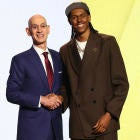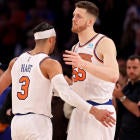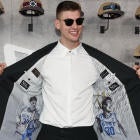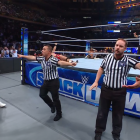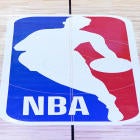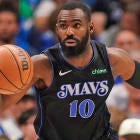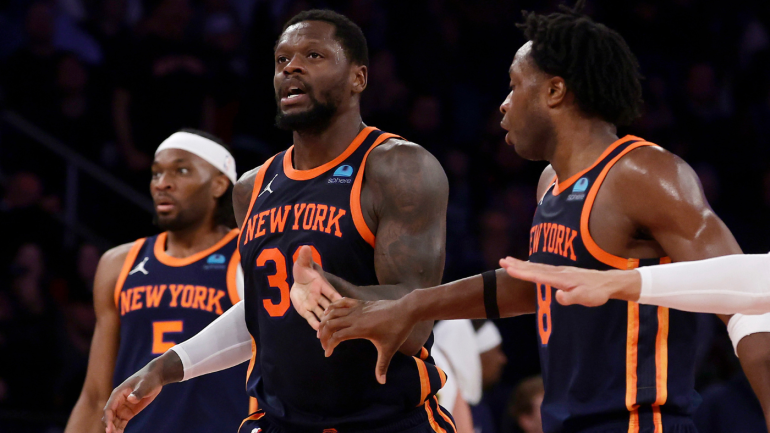
The New York Knicks made the biggest move of the NBA offseason late Tuesday night when they reportedly landed Mikal Bridges in a trade with the Brooklyn Nets. In some ways, the move feels like the completion of the roster the Knicks have been building for years. The Villanova teams that won national championships in 2016 and 2018 had four players emerge as successful professionals: Bridges, Jalen Brunson, Josh Hart and Donte DiVincenzo. Now, all four of them are Knicks.
But in more practical terms, the deal leaves the Knicks in a somewhat incomplete state. New York now has only seven players under guaranteed contracts for next season, and even though all of them are essential parts of the rotation, this team has a long way to go before it can call itself the championship contender Tuesday's blockbuster was designed to create. So with the biggest move now out of the way, let's look at what comes next as New York attempts to round out what might be its best roster in decades.
The draft
First things first: the Knicks may have traded a boatload of draft picks to the Nets in this deal, but none of them will come in 2024. That still leaves the Knicks with three very valuable picks on Wednesday and Thursday: No. 24 and No. 25 overall in the first round and No. 38 in the second.
Yes, this is a weak draft class, and yes, those picks aren't exactly high on the board, but think of New York's recent drafting history. Leon Rose landed Immanuel Quickley at No. 25 in 2020 and Deuce McBride at No. 36 in 2021. The Knicks are drafting in the same range this time around. Those are obviously low-odds draft slots overall, but the Knicks don't need to hit on all three of them. Just nailing one would make a huge difference moving forward.
We'll get into New York's short-term finances momentarily, but for the moment, let's talk about the longer-term. Jalen Brunson will be on a new contract when the 2025-26 season begins, and it is going to be substantially more expensive. Mikal Bridges will have a deal in time for the 2026-27 season. If Mitchell Robinson is still around, he will have to get paid as well. The Knicks have done a wonderful job of signing players to value deals in recent years, but those deals are now expiring and their best players are getting expensive. Having contributors on cheap rookie deals is going to make an enormous difference moving forward.
The cap
All right, let's take a look at the Knicks' balance sheet as of this moment. We are going to assume that the non-guaranteed contracts of Mamadi Diakite and DaQuan Jeffries are not on the books, but that New York picks up its team option on Jericho Sims. That would leave the Knicks with eight players. Their two first-round picks will be paid according to their scale slots. The exact figure for the second-round pick will depend on the length of the contract the Knicks sign each to using the new second-round pick exception, but we will assume it is a four-year deal in order to maximize that player's long-term value. Note, though, that this figure will be a projection. That leaves New York with 11 roster spots accounted for. Here are those numbers laid out:
| Player | Salary |
|---|---|
$28,939,680 | |
Jalen Brunson | $24,960,001 |
Mikal Bridges | $23,300,000 |
Josh Hart | $18,144,000 |
Mitchell Robinson | $14,318,182 |
Donte DiVincenzo | $11,445,000 |
Deuce McBride | $4,710,144 |
Jericho Sims | $2,092,344 |
No. 24 overall pick | $2,833,800 |
No. 25 overall pick | $2,720,040 |
No. 38 overall pick | $2,093,637 |
Total | $135,556,828 |
Projected first apron | $178,655,000 |
Projected second apron | $189,485,000 |
Why did we include those two apron figures? Because this deal is going to create a hard cap for the Knicks in some fashion. The new CBA has created a number of new circumstances under which teams can be prevented from exceeding a certain threshold of total salary. Those two thresholds are the first and second apron, which we've projected in the table above.
When a team takes back more money than it sends out in a trade, it becomes hard-capped at the first apron. Bojan Bogdanovic makes less than Bridges next season, so if he is the only Knicks player in the deal, they would be hard-capped at that $178.7 million figure.
When a team aggregates multiple salaries to fit in a single, specific player, though, it becomes hard-capped at the second apron, which is roughly $11 million higher. This is enormously important for the Knicks given how tight their budget looks for next season. However, despite earlier reports suggesting that the Knicks could achieve this by merely including the salaries of Diakite and Jeffries, they actually cannot be aggregated because they are on minimum deals. Therefore, if they want to aggregate, they are going to either have to trade an existing player on the roster making more than the minimum (so anyone but Diakite, Jeffries or Sims), or they are going to have to bridge the gap by signing-and-trading one of their free agents elsewhere.
It is likely that the Knicks find some way to make this an aggregation trade rather than a one-for-one swap because of how badly they would need that extra room under the hard cap. However, the exact form that takes is still undecided. The Knicks do not to send more salary to the Nets, specifically. They just have to send more salary out in the total deal, which can include however many other teams as it takes. Typically, when trades are made at this time of year, teams are flexible in allowing partners time to expand deals and include other teams. As we speak, the Knicks are likely weighing options involving several other players and teams in order to make this aggregation possible. It hasn't been reported because the Knicks likely don't have another trade partner lined up yet.
So using the figures we have above, the Knicks would have roughly $43 million in room beneath the first apron and around $54 million in room beneath the second. Remember, these figures are subject to change right away. If the Knicks move any draft picks on Wednesday or Thursday, the numbers shift slightly. Say they dump their second-round pick. Around $2.1 million comes off of the board... but that also creates an extra roster spot that needs to be filled. There are even scenarios in which the Knicks could choose the first apron hard cap, though they are less likely. In short, the Knicks have more moves coming. We don't know what they will be yet.
On a more drastic level, it's possible that the Knicks look to create significantly more room under these lines. Mitchell Robinson has been in trade rumors all week, for instance. If the Knicks moved him into someone else's cap space, that's another $14.3 million in apron room to play with in addition to satisfying our aggregation requirements. The Knicks could also try to trade a bigger salary for a smaller one in service of that same goal. They could, for instance, trade Randle's $28.9 million salary to a team with cap space for a cheaper, lower-usage player that would save some money. Considering the free agency scenarios we are about to discuss, something like that may well be on the table, especially since there are going to be fewer shots to go around now.
Free agency and trades
The Knicks have two key free agents to attend to before even considering any more outside help. OG Anunoby is an unrestricted free agent with full Bird Rights. Isaiah Hartenstein is an unrestricted free agent with Early Bird Rights. Those distinctions are important.
Both Anunoby and Hartenstein are free to leave the Knicks if they choose. However, Anunoby's full Bird Rights give the Knicks the right to pay him anything up to his max provided his salary does not take them above whatever hard cap they operate under. Hartenstein's Early Bird Rights are more complicated. The Knicks can only give him a 75% raise on his salary from last season. That caps New York at roughly $16.2 million for him next season and roughly $72.5 million over the four-year life of the deal. If another team offers him more, well, there's nothing the Knicks can do about it.
Reports thus far have indicated that the Knicks are prioritizing keeping Anunoby, and that there is a real chance that they lose Hartenstein. Anunoby's price could reach as high as his projected max of $42.3 million. If that is what it takes to sign him, the Knicks wouldn't have room to sign Hartenstein even at that $16.2 million figure with their books in their current state. That leaves New York with a few options.
The first would be to simply allow Hartenstein to walk and then turn their attention toward Precious Achiuwa, whom they acquired in the Anunoby deal and they still have full Bird Rights on. Robinson is capable of serving as a starting center when healthy, and Achiuwa would be an acceptable backup behind him. That's not quite the two-headed monster New York had early last season, but it's a passable short-term center rotation.
If Hartenstein is willing to come back at that $16.2 million figure, the Knicks would likely trade Robinson to accommodate him. They would then use those savings to presumably target a cheaper backup center. Achiuwa is the obvious name here. However, we should note that no matter what hard cap the Knicks are locked beneath, they will have a mid-level exception of some variety at their disposal as well. If they are locked at the first apron, it's the non-taxpayer mid-level exception. If it is the second apron, they would have the taxpayer mid-level exception. Other possible center to explore in free agency would include Jonas Valanciunas, Andre Drummond, Xavier Tillman and Mo Wagner, though given the relatively thin group of available centers, demand for those players will probably be high.
Here's where things start to get a bit more ambitious. Let's say, hypothetically, the Knicks could find a cap space team to absorb Randle outright. Suddenly, New York goes from $54 million in second apron room to $83 million. Even with Anunoby and Hartenstein at their maxes and Robinson still on the books, that scenario would leave the Knicks with around $25 million in room beneath the second apron and $14 million in room beneath the first. Such scenarios would allow the Knicks to explore virtually any mid-level free agent or potentially go shopping on the trade market with some of their leftover draft picks and the trade exception moving Randle would create. Or, in a simpler move, they could fill in some of that budget by trading Randle for a cheaper player instead of pure financial freedom.
Is a Randle move on the table? There is no reporting suggesting that it would be, but remember, virtually every Knicks star trade scenario over the past few years has included Randle as the matching salary. There are reasons for that beyond financial necessity. Randle's value is tied closely to his usage. He needs the ball. Are there going to be enough shots for him on a team with Brunson, Bridges, DiVincenzo, Anunoby, Hart and McBride? That's debatable. Randle is a two-time All-Star. He might also be more of a floor-raiser for growing teams than a ceiling-raiser for championship contenders. Anunoby's likely return will prevent all four Villanova players from starting together, but moving Randle would at least open the door for three of them. It would also maximize spacing and defense on a team that is now prioritizing those things. All in all, a Randle trade is likelier as a financial necessity than an active stylistic basketball decision. Expect one of the centers to go, but Randle is at least a possibility.
So let's game out the likeliest scenario here. If Anunoby re-signs and the Knicks wind up with Achiuwa backing up either Robinson or Hartenstein at center, they would have 13 roster spots filled (or, potentially, 12 if their second-round pick signs a two-way deal). What should the Knicks be looking for out of their last few roster spots? A traditional backup point guard should be a priority. New York's offense fell off of a cliff whenever Brunson rested last season, and even if Tom Thibodeau probably wouldn't use a minimum-salary backup in the regular rotation, having one available in case Brunson gets hurt would be important. If Robinson is the starter at center instead of Hartenstein, it might not be the worst idea to even carry a fourth center behind him, Achiuwa and Sims. His injury issues make depth critical at that position.
The Knicks are the rare teams that's more or less set on the wing, assuming Anunoby returns. Anunoby, Hart, DiVincenzo and McBride were already a formidable group. Adding Bridges to the group not only improves it, but adds a layer of security. Bridges has never missed an NBA game. His track record says he's going to be healthy, which, as the Knicks saw against Indiana, may not be the case for everyone else given Thibodeau's high-minutes philosophy for his starters. The goal now will be securing the rest of the roster, but with the hardest part already done, New York is well-positioned to make a serious run at the 2025 title.










